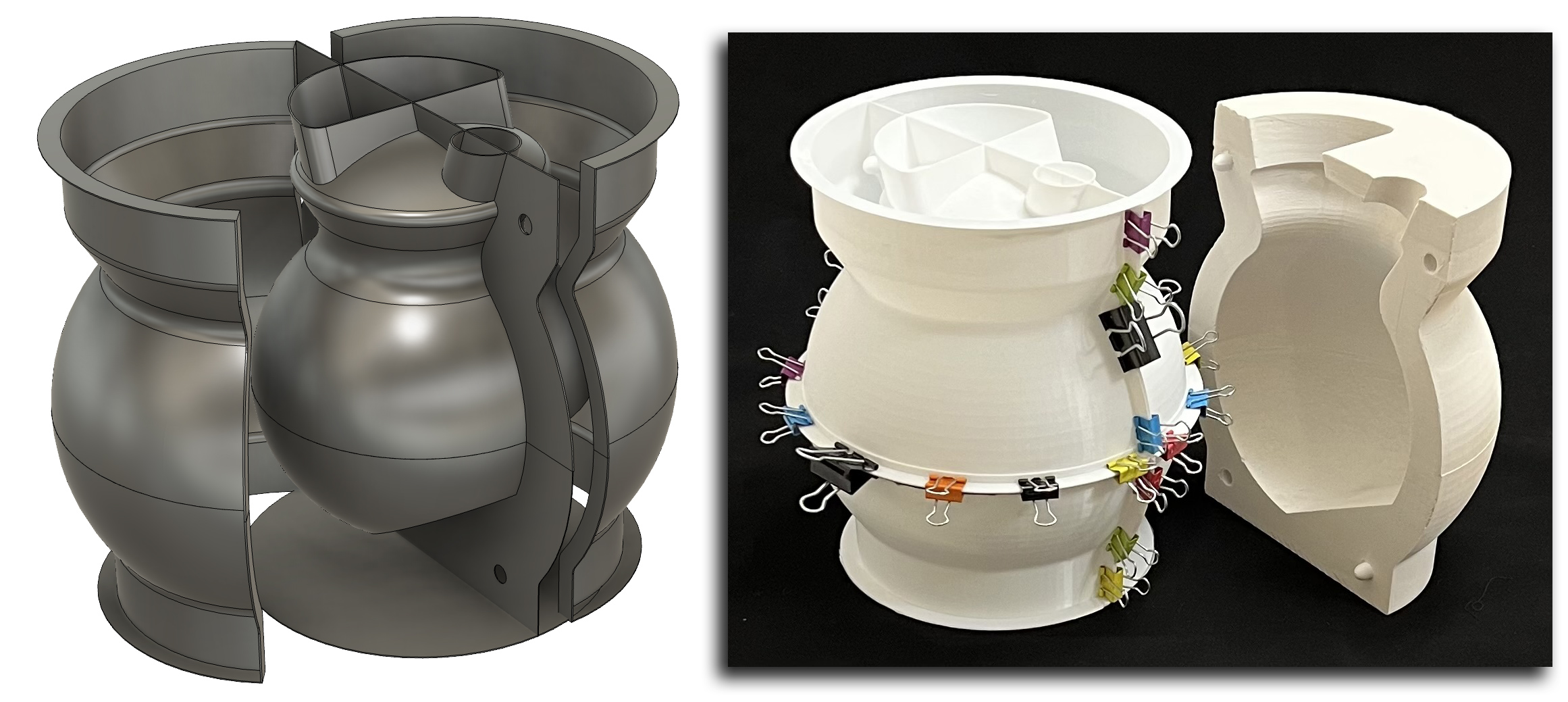| Monthly Tech-Tip | No tracking! No ads! | |
Flanges enable an all-in-one 3D printed block mold for slip casting
The center piece of this 3D printed assembly defines the outside shape of the ceramic vessel (plus two spares at the top). This entire assembly is an all-in-one case mold for a two-piece plaster working mold. This was printed as six light-weight units on standard Prusa MK3 and MK4 printers, walls are 0.8mm thickness. The upper and lower inside model halves were glued together (with the aid of an inside hoop to line them up). Outer flanges were glued on to enable clamping the outer shell vertically and horizontally.
The membranes defining mold mating points are printed onto the inside model, they extend out far enough to clamp between the flanges of the outer shell sections (suspending the model in the center). The membranes have holes to enable inserting natch-pairs. The thin base is glued on to hold the lower outer shells in place (in flexes enough to enable extracting the plaster form without mold breakage). The whole assembly is held together by clamps so it can be used multiple times.
Related Pictures
Fastest possible 3D print of a case mold part
I am 3D printing half of the bottom section of the outside shell assembly of an all-in-one case mold (to make a plaster mold for casting pottery). There are multiple factors to take into account to make this print quickly with minimum material and yet be strong.
- Notice the green 3mm wide brim all around the base (in the slicer view top right). The slicer generates that when asked, it helps stick the part to the printer bed.
- Flanges are present on all sides of these to enable clamping them together. The overall shape and flanges on a ready-to-pour assembly make for plenty of strength. However, the top, which is actually the down side when assembled, prints with no flange (so no printed support is needed). I print separate flanges (shown between the top and bottom pieces (on the left) and glue them on.
- I design with 0.8mm thick walls, these thus print in two passes (see video). This piece prints in about an hour on my machine. It weighs only 36g.
- If the flanges are not 0.8mm thick the printer makes separate motions there risking catching the edge and flexing the print on each pass (this eventually loosens it from the bed).
3D Printing an entire one-off case mold in one piece
This 3D printed shell encloses an entire two-piece mold for v 5.0 Medalta Potteries ball pitcher - all that is needed is to fill it with plaster and peel off the PLA casing after it sets. We are still in the development stages so the fact that this will only produce one mold is fine. The membrane across the center is where the two mold halves mate (it also holds the inner model in place). The membrane has holes where natch-pairs can be mated for embedding into the plaster mold. The spare (shown lower right) will be rotated 90 degrees, it has a slot that fits snuggly over the membrane to hold it in place. The handle is being done separately. This was printed on a consumer 3D printer with standard PLA filament.
Videos
Links
| Glossary |
0.8mm thickness
This is an ideal wall thickness to print on consumer 3D printer since to normally creates sufficient strength and prints in one two passes |
| Glossary |
All-in-one case mold
A method of 3D printing the case mold shell of an entire assembled plaster mold for using in ceramic production. |
| Glossary |
Mold Shell Flange
Learning to create flanges in CAD design enables a new kind of DIY mold-making for ceramics: 3D-printed lightweight reusable molds that clamp together. |
Got a Question?
Buy me a coffee and we can talk

https://digitalfire.com, All Rights Reserved
Privacy Policy

